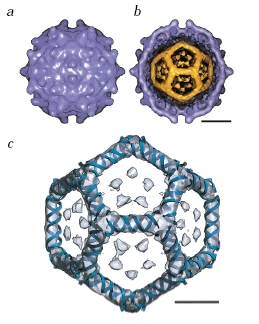- You have a homework due today.
- You had a homework due next time, too, but I'll postpone that until Tuesday of next week (the 28th)
- Our next test is Tuesday, 11/4
- We begin our discussion with the convex regular
polygons:
"A regular polygon is a polygon which is equiangular (all angles are equal in measure) and equilateral (all sides have the same length). Regular polygons may be convex or star."
- Just FYI: Star
Polygons (Be thinking of your logos!)
Here are the convex ones:
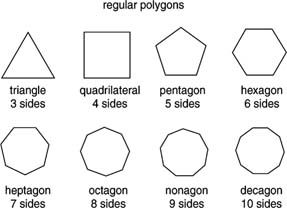
- As an example, consider regular convex hexagonal
graph paper, which represents a tiling of the plane by a
regular convex polygon. You see these kinds of tilings in bathrooms.
- Now, let's move on to solids. A cube is an example of a Platonic
solid. It's the one we're most familiar with.
A Platonic solid is a solid for which
- All faces are congruent (identical) convex regular polygons, and
- Each face, each edge, and each vertex is exactly equivalent to every other face, edge, or vertex (respectively).
- We'll start by trying to make some. How many Platonic solids are
there, do you suppose?
Let's try making some using magnetic kits ("geomags").
By the way, you'll have to put these kits away. Please be careful as you take them apart, and play with them! I need them back neatly in their boxes.
- As a homework, I am asking you to cut and create Platonic solids
out of paper, using this template. You
may use these as a cheat sheet for the next exam. You must have put
them together, however, and you must use only your own.
- What's wrong with six sided polygons, and beyond? Consider your
hexagonal paper, of the tiling of the plane: why can't it be folded up
into a solid?
- Johannes Kepler thought that the orbits of the planets (of which
five were known at the time) were somehow related to the various
Platonic solids, as shown in this
figure.
"The six spheres each corresponded to one of the planets (Mercury, Venus, Earth, Mars, Jupiter, and Saturn). The solids were ordered with the innermost being the octahedron, followed by the icosahedron, dodecahedron, tetrahedron, and finally the cube. In this way the structure of the solar system and the distance relationships between the planets was dictated by the Platonic solids."
The Five Convex Regular Polyhedra (Platonic solids) -- thanks Wikipedia! Tetrahedron Hexahedron
or CubeOctahedron Dodecahedron Icosahedron 




- Now let's use our sets of Platonic solids to fill in the
following table:
# of Vertices Edges Faces faces at each vertex sides at each face Tetrahedron 4 6 4 3 3 Cube 8 12 6 3 4 Octahedron 6 12 8 4 3 Dodecahedron 20 30 12 3 5 Icosahedron 12 30 20 5 3 What conclusions can we draw from this data? Is there a pattern? (Of course there is!:)
- The pattern leads to the concept of "Duality"
- Each Platonic solid has a "twin" -- called its dual -- which we can discover from the table.
- Duality in nature:

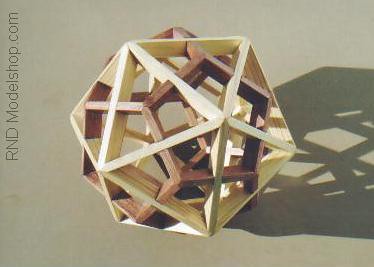
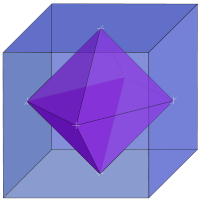
- Each Platonic solid has a "twin" -- called its dual -- which we can discover from the table.
- Something interesting to share: great images from Linus Pauling's and Roger Hayward's The Architecture of Molecules (a book created especially for young people, and based off of Pauling's article in the 1964 Proceedings of the National Academy of Sciences.
These are some higher quality images than my scans:
- So what can you do with a dodecahedron? Look like a super-brainy, cool scientist!
From the October 7th, 2011 New York Times
- Icosahedron
- amoeboid protozoa Circogonia icosahedra
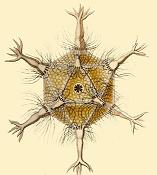
- Viruses:
- The Cliff Notes Version...

"An array of viruses. (a) The helical virus of rabies. (b) The segmented helical virus of influenza. (c) A bacteriophage with an icosahedral head and helical tail. (d) An enveloped icosahedral herpes simplex virus. (e) The unenveloped polio virus. (f) The icosahedral human immunodeficiency virus with spikes on its envelope."
- Bacteriophages and Virions
- The Cliff Notes Version...
- Dodecahedral
- amoeboid protozoa Circogonia icosahedra
- How can we draw the Platonic solids on a sheet of paper? We project them onto the paper.
- The cube you've undoubtedly done before.
- The tetrahedron can be drawn to be a "distorted" Mercedes symbol
- Here are all the solids. Practice drawing them! Where's the duality?
